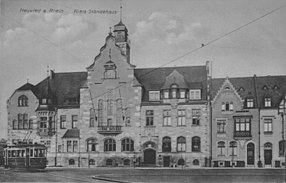Neuwied tram
| Neuwied tram | |
|---|---|
| Tram in front of the Kreis-Ständehaus (1910) | |
| Basic information | |
| Country | Germany |
| city | Neuwied |
| opening | July 29, 1901 |
| Shutdown | October 31, 1950 |
| Infrastructure | |
| Route length | 20 km |
| Gauge | 1000 mm ( meter gauge ) |
| Depots | 1 |
| business | |
| Lines | 3 |
The Neuwied tram was a tram system operated in the city of Neuwied am Rhein and its surroundings . It was around 20 kilometers long, fully electrified, mostly single-track and meter-gauge . After its closure , the tram was replaced by the Neuwied trolleybus .
history
The first line was 6.7 kilometers long and still licensed as a small railway . It was opened on July 29, 1901 by the Neuwied-Oberbieber district railway between Neuwied and Oberbieber station. The depot was also located in this northern neighboring town . From May 1, 1907 - after the abandonment of low freight traffic - the legal provisions for trams applied to this route.
On December 4, 1909, the existing route was extended by 12.3 kilometers from Neuwied to the neighboring town of Engers and turning north to Gladbach . At the same time, a 1.1 kilometer connection from the train station to the banks of the Rhine was added within Neuwied. From then on, three lines ran , all of which started from the banks of the Rhine. One to Oberbieber, the second to Gladbach and the third inner-city to the train station. The old depot was replaced by a new depot in the east of the city center on Engerser Landstrasse. As a result of the new routes, the company was now called Neuwied Kreisbahnen .
The expansion was carried out by the railway construction company Becker & Co GmbH from Berlin, which also ran the facility until 1922. This was taken over in 1924 by the newly founded municipal power supply Rhein-Wied AG in Neuwied. From December 4, 1928, it also operated omnibus lines in Neuwied and the surrounding area.
From the extensive expansion plans planned at the time - for example a connection along the Rhine to Bad Honnef with a connection to the standard-gauge Siebengebirgsbahn - only insignificant changes in the city network were implemented. Since 1926 there were only two lines on the network, which had a circumference of 18.7 kilometers. Since the line to Gladbach now touched the station, the separate line there was no longer applicable. The inner city route to the Rhine was destroyed in the Second World War at the end of 1944. Therefore, in 1946 the two previous lines were combined to form a diameter line from Oberbieber to Gladbach.
After five decades, the railway could only have continued to operate after costly renovation work. The connection between Engers and Bendorf - Sayn to the Koblenz tram network , which has always been sought, also no longer seemed feasible in view of the development there.
So the decision was made to convert the entire network to trolleybus operation. On October 1, 1949, rail traffic on the Neuwied - Engers - Gladbach route was discontinued, and Neuwied - Oberbieber followed on October 31, 1950. This was the first complete shutdown of a tram in Germany after the end of the Second World War that was not due to its immediate consequences. The vehicles were handed over to the Aachen tram .
literature
- Dieter Höltge: Deutsche Straßen- und Stadtbahnen, Volume 4: Rhineland-Palatinate / Saarland, Gifhorn 1981, ISBN 978-3-9212-3760-1

